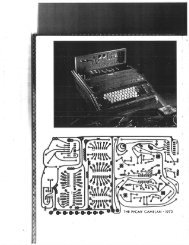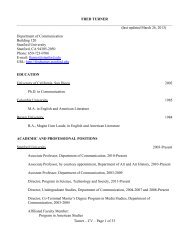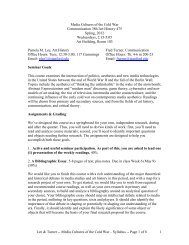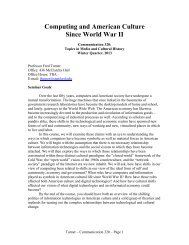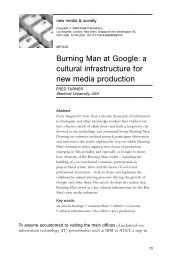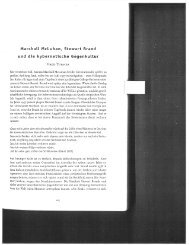Journal of Visual Culture - Fred Turner - Stanford University
Journal of Visual Culture - Fred Turner - Stanford University
Journal of Visual Culture - Fred Turner - Stanford University
Create successful ePaper yourself
Turn your PDF publications into a flip-book with our unique Google optimized e-Paper software.
6 journal <strong>of</strong> visual culture 7(1)<br />
monitoring ensembles <strong>of</strong> human and machine actors, working in concert<br />
toward the production <strong>of</strong> goods. Human and machine in turn resembled one<br />
another: both processed information, both performed work, and both were<br />
to be watched over by a hierarchy <strong>of</strong> executive experts. For Diebold, this<br />
resemblance promised greater efficiency in manufacturing but, for much <strong>of</strong><br />
the public, it provoked a quiet terror. In Congressional hearings, in the<br />
smoking rooms <strong>of</strong> labor halls and in the pages <strong>of</strong> women’s magazines, the<br />
automated factory soon became an emblem <strong>of</strong> a mechanistic, hierarchical<br />
society (Bix, 2000: 237–75). At the heart <strong>of</strong> that society lay the possibility <strong>of</strong><br />
physical replacement and psychological fragmentation: computers would do<br />
the analytic work <strong>of</strong> all but the highest-level managers and what managers<br />
were left would become ever-more machine-like in the way they did their<br />
jobs. The factory itself would become a shell, hollowed <strong>of</strong> meaning, and<br />
machine-based labor – especially information-machine-based labor – would<br />
dehumanize all those who undertook it.<br />
Yet, even as pundits and labor leaders were decrying the potential consequences<br />
<strong>of</strong> automation, a series <strong>of</strong> avant-garde artists were transforming the<br />
theories <strong>of</strong> subjectivity on which visions <strong>of</strong> the automated factory depended.<br />
1952 was also the year that John Cage, Robert Rauschenberg and half a dozen<br />
compatriots at Black Mountain College staged what has since been recognized<br />
as the first Happening. What actually happened at the event remains in<br />
some dispute, but the usually reliable Calvin Tomkins has described a<br />
gathering in the Black Mountain dining room after dinner, during which<br />
Cage delivered a lecture from a ladder, Merce Cunningham danced through<br />
the audience trailed by a dog, David Tudor played the piano, Charles Olson<br />
and M.C. Richards read poetry, and movies and still photographs flickered<br />
across the surfaces <strong>of</strong> Rauschenberg’s White Paintings. When the activity<br />
ended, the participants picked up a series <strong>of</strong> tea cups that had been set on<br />
clusters <strong>of</strong> chairs and walked away.<br />
On the face <strong>of</strong> it, this evening would seem to have nothing to do with<br />
computers, automation and the factory floor. And, to date, scholars have in<br />
fact analyzed Happenings and the automation debates within two very<br />
separate fields: the history <strong>of</strong> art and the history <strong>of</strong> technology, respectively.<br />
Yet, in this case, the history <strong>of</strong> artistic practice and the history <strong>of</strong> the<br />
integration <strong>of</strong> computing into everyday life need to be seen as entwined. The<br />
automation debates and the Happening at Black Mountain grew out <strong>of</strong> a<br />
remarkably similar understanding <strong>of</strong> human subjectivity. Artists such as Cage<br />
and Rauschenberg each viewed themselves and their creations as elements in<br />
socio-technical production systems – systems that had to be automated to<br />
function properly. In the postwar years, these artists and others around them<br />
transformed the erasure <strong>of</strong> self, so feared by opponents <strong>of</strong> business<br />
automation, into the basis <strong>of</strong> a new form <strong>of</strong> artistic agency and a new,<br />
collaborative social style specifically opposed to the hierarchies <strong>of</strong> the<br />
automated factory – an agency and a style that I will call ‘Romantic<br />
automatism’. Then, in a series <strong>of</strong> performances at the end <strong>of</strong> the 1960s, Cage,<br />
Rauschenberg and others presented this transformed subjectivity to the<br />
leaders <strong>of</strong> American industry and American labor – the same leaders who had<br />
Downloaded from<br />
http://vcu.sagepub.com at <strong>Stanford</strong> <strong>University</strong> on March 20, 2008<br />
© 2008 SAGE Publications. All rights reserved. Not for commercial use or unauthorized distribution.



